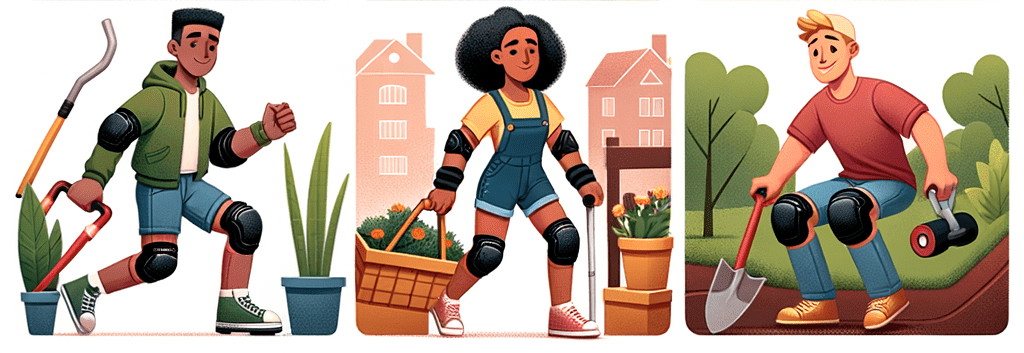Knee injuries can happen in an instant, but leave you suffering pain and medical bills for months or even years afterward. Last year while doing some gardening, I kneeled awkwardly on a sharp rock. A bolt of pain shot through my knee and I struggled to stand up, almost toppling over the flowerbed. An MRI later showed a partial meniscus tear that took 6 months of physical therapy to heal. If only I had been wearing knee pads!
Table of Contents

Knee injuries are incredibly common, accounting for nearly 45% of all sport and recreation injuries according to research from the Mayo Clinic. From gardening mishaps to construction site accidents to sports injuries, damages to the knee come with huge costs. The average knee injury requires over $15,000 in medical treatments and results in 6 weeks of missed work on average.
Wearing proper knee pads can help prevent many common knee injuries and provide many other benefits as well. This article will discuss the top 10 reasons you should wear knee pads during activities that put stress and impact on your knees.
Types of Knee Pads
There are two main types of knee pads available:
- Rigid plastic or metal exterior cap
- Straps to tightly secure around the leg above and below the knee
- Provide maximum protection from impacts
- Can feel bulky and restrict movement
Soft Knee Pads
- Made from foam padding, neoprene, spandex, or other fabrics
- Cushioned but flexible protection
- Slip-on sleeve design for easy on/off
- More comfortable for long-wear
- Less protective for high impacts
Consider your activity, the surface you’ll be on, and the duration you’ll be wearing them when choosing between heavy-duty hard shell pads or flexible soft pads. Basketball, construction work, and crawling on rough ground call for maximum protection. Yoga, gardening, or extended wear may prioritize comfort and mobility.

Preventing Knee Injuries
Wearing knee pads is one of the most effective ways to prevent many common knee injuries:
- Avoid abrasions and lacerations – Knee pads protect your skin from scraping across rough concrete, turf, or natural rock surfaces that can shred skin.
- Prevent bruising and inflammation – The padding cushions your knee joint from repeated impacts that cause painful bruising and swelling of tissues.
- Avoid dislocated kneecaps – The patella can shift out of place during sudden twists or blows. Knee pads stabilize the kneecap and prevent dislocation.
- Reduce risk of fractured patella – The hard shell cap distributes and absorbs the force of direct blows to the knee that could otherwise crack the patella bone.
- Avoid torn meniscus – The meniscus cartilage between the knee bones acts as a shock absorber. Knee pads prevent tears from excessive twisting, force, and pressure.
- Prevent bursitis – Cushioning the knee prevents inflammation or irritation of the bursa sacs around the kneecap that causes debilitating pain.
Benefits of Wearing Knee Pads
Beyond just injury prevention, knee pads provide many other advantages:
- Save money on medical bills – Knee pad prevention avoids expensive emergency room visits, MRIs, surgeries, physical therapy, and other costs of knee injuries.
- Reduce pain and discomfort – Knee pads allow you to kneel comfortably on hard surfaces like concrete for long periods without pain.
- Improve work efficiency – Workers stay energized and productive without the fatigue and discomfort of kneeling on hard ground.
- Give confidence in trying new activities – Knee pads allow you to kneel, crawl, and slide without fear of scraping or bruising your knees, making new activities less daunting.
Choosing the Right Knee Pads
- Activity – Are you mountain biking or flooring? Playing sports or doing yoga? Pick pads designed for your activity.
- Duration – Will you wear them for hours? Opt for well-ventilated and comfortable pads. Just a brief use can get bulkier models.
- Surface – Rough concrete and trails need more durable caps and padding than smooth floors.
- Weather – Sweat-wicking and cooling features help in hot conditions. Insulated pads work in cold.
- Fit – Measure your knee circumference for a snug but flexible fit. Straps should be adjustable.
- Comfort – Softer pads are more comfortable for extended wear. Hard shells can pinch and rub.
- Adjustability – Having straps that securely tighten but don’t cut off circulation is ideal.
Consider tradeoffs – Hard shell caps provide maximum protection but can sacrifice comfort and mobility. Foam pads are more flexible but less protective. Choose what’s ideal for your needs.

Proper Use and Care of Knee Pads
Using knee pads properly preserves their protective abilities and lifespan:
- Strapping – Secure straps firmly but not too tight. Allow for some circulation and movement.
- Placement – Center pads evenly over the kneecap. Anchor above and below the joint.
- Inspect for damage – Check for cracks, loosening, and worn-out padding after use.
- Cleaning – Wipe off dirt and sanitize regularly. The wash padding cover is removable.
- Storage – Hang pads or store flat. Don’t fold or crease, which can crack shells.
Taking care of your knee pads and wearing them correctly ensures they provide maximum protection and last longer. Replace any damaged pads immediately.
Conclusion
Knee injuries can happen suddenly but take months to recover from. Wearing quality knee pads suited for your activity helps avoid skinned knees, bruising, dislocations, fractures, and cartilage tears. Beyond just injury prevention, knee pads reduce pain, improve work efficiency, save on medical costs, and give confidence to take on new activities. Investing in knee protection now can prevent months of frustration and medical treatment down the road. The next time you kneel, make sure you have knee pads that can take the impact!
